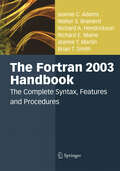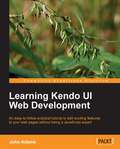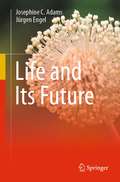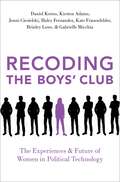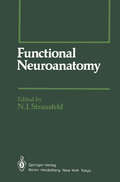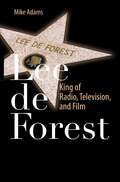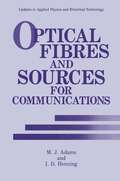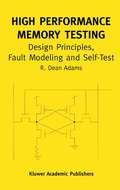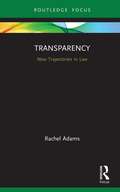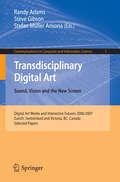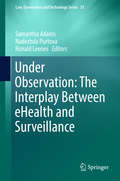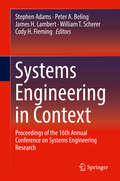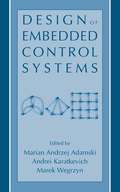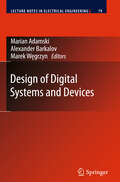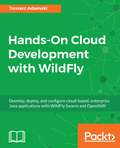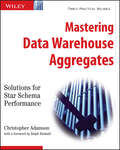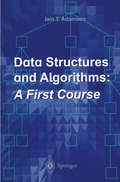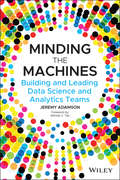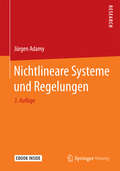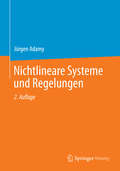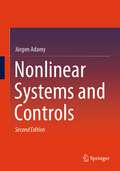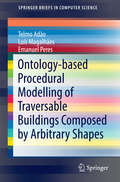- Table View
- List View
The Fortran 2003 Handbook: The Complete Syntax, Features and Procedures
by Jeanne C. Adams Walter S. Brainerd Richard A. Hendrickson Richard E. Maine Jeanne T. Martin Brian T. SmithThe Fortran 2003 Handbook is a definitive and comprehensive guide to Fortran 2003 and its use. Fortran 2003, the latest standard version of Fortran, has many excellent features that assist the programmer in writing efficient, portable and maintainable programs. This all-inclusive volume offers a reader-friendly, easy-to-follow and informal description of Fortran 2003, and has been developed to provide not only a readable explanation of features, but also some rationale for the inclusion of features and their use. This highly versatile handbook is intended for anyone who wants a comprehensive survey of Fortran 2003.
Learning Kendo UI Web Development
by John AdamsA practical tutorial with step-by-step example based approach.This book is for web developers who want to take advantage of cutting edge JavaScript and HTML 5 web site features, but who don't have the time or the knowledge to write all of that code by hand. The reader should be familiar with basic HTML 5 and JavaScript but does not need to be an expert.
Life and Its Future
by Josephine C. Adams Jürgen EngelThis book is aimed at those who wish to understand more about the molecular basis of life and how life on earth may change in coming centuries. Readers of this book will gain knowledge of how life began on Earth, the natural processes that have led to the great diversity of biological organisms that exist today, recent research into the possibility of life on other planets, and how the future of life on earth faces unprecedented pressures from human-made activities. Readers will obtain a perspective on the potential risks of chemical or nuclear warfare, and the ever-increasing risks from human activities that are causing pollution and climate change with global heating. Readers will also learn about ongoing research efforts to generate “designer lifeforms” through synthetic biology and applications of artificial intelligence. The book makes an integrated, up-to-date, overview of topics often considered as separate fields. It should be valuable to students, teachers, and people who are concerned about the future of life.
RECODING THE BOYS' CLUB OSDP C: The Experiences and Future of Women in Political Technology
by Kirsten Adams Daniel Kreiss Jenni Ciesielski Haley Fernandez Kate Frauenfelder Brinley Lowe Gabrielle MicchiaThe #MeToo movement has catalyzed an international discussion about the routine challenges women face in their professional lives as a result of male-dominated industries and office cultures. These include well-documented cases of sexual harassment and assault, but also unequal opportunities, unequal pay, sexist stereotypes, and a devaluation of women's labor. While these are problems women face in all industries and at all levels, the political and technology sectors are particularly rife with them. Recoding the Boys' Club is a ground-breaking deep-dive into the work experiences of women in the political technology field in the United States. Political technology sits at the intersection of two fields dominated by men--politics and technology--and has become a cornerstone of operations in political campaigns and political institutions more generally. Drawing on a unique dataset of 1004 staffers working in political technology on presidential campaigns from 2004-2016, analysis of hiring patterns during the 2020 presidential primary cycle, and interviews with 45 women who worked on 12 different presidential campaigns, this book reveals the underrepresentation of women in political technology, especially leadership positions, as well as the struggle women face to have their voices heard within the "boys' clubs" and "bro cultures" of political technology. It chronicles the gendered expectations women face to provide emotional labor, stereotypes about women's competencies that shape their opportunities, the ways in which women's ideas are discredited, and the formal and informal forms of exclusion in campaign culture--leading to widespread feelings of "imposter syndrome" among women in this environment. These issues are often compounded by a mentality that the well-being of staffers must come secondary to the goals of the campaign, despite what campaigns might profess publically about gender and labor. Since these campaigns are important entry and training points for the wider field of political technology, the gendered inequities encountered within them have implications for women's professional experiences and careers long after campaigns have ended. This book aims to help political practitioners create more gender equitable and inclusive workplaces, ones that value the ideas and skills of all those who work to get candidates elected.
Functional Neuroanatomy (Springer Series in Experimental Entomology)
by M. E. Adams J. S. Altman J. P. Bacon U. K. Bassemir C. A. Bishop E. Buchner H. Bülthoff S. D. Carlson Chi Che F. DelComyn H. Duve M. Eckert T.R.J. Flanagan G. Geiger C. H. Hackney B. Hengstenberg R. Hengstenberg N. Klemm D. R. Nässel M. O Shea W. A. Ribi R.L. Saint Marie H. S. Seyan P. T. Speck N. J. Strausfeld A. Thorpe J. Ude D. W. WohlersThe "functional" in the title of this book not only reflects my personal bias about neuroanatomy in brain research, it is also the gist of many chapters which describe sophisticated ways to resolve structures and interpret them as dynamic entities. Examples are: the visualization of functionally identified brain areas or neurons by activity staining or intracellular dye-iontophoresis; the resolution of synaptic connections between physiologically identified nerve cells; and the biochemical identification of specific neurons (their peptides and transmitters) by histo- and immunocytochemistry. I personally view the nervous system as an organ whose parts, continuously exchanging messages, arrive at their decisions by the cooperative phenome non of consensus and debate. This view is, admittedly, based on my own ex perience of looking at myriads of nerve cells and their connections rather than studying animal behaviour or theorizing. Numerous structural studies have demonstrated that interneurons in the brain must receive hundreds of thousands of synapses. Many neurons receive inputs from several different sensory areas: each input conveys a message about the external world and possibly also about past events which are stored within the central nervous system. Whether an interneuron responds to a certain combination of inputs may be, literally, a matter of debate whose outcome is decided at the post synaptic membrane. A nerve cell responding to an overriding command is possibly a rare event.
Lee de Forest: King of Radio, Television, and Film
by Mike AdamsThe life-long inventor, Lee de Forest invented the three-element vacuum tube used between 1906 and 1916 as a detector, amplifier, and oscillator of radio waves. Beginning in 1918 he began to develop a light valve, a device for writing and reading sound using light patterns. While he received many patents for his process, he was initially ignored by the film industry. In order to promote and demonstrate his process he made several hundred sound short films, he rented space for their showing; he sold the tickets and did the publicity to gain audiences for his invention. Lee de Forest officially brought sound to film in 1919. Lee De Forest: King of Radio, Television, and Film is about both invention and early film making; de Forest as the scientist and producer, director, and writer of the content. This book tells the story of de Forest’s contribution in changing the history of film through the incorporation of sound. The text includes primary source historical material, U.S. patents and richly-illustrated photos of Lee de Forest’s experiments. Readers will greatly benefit from an understanding of the transition from silent to audio motion pictures, the impact this had on the scientific community and the popular culture, as well as the economics of the entertainment industry.
Optical Fibres and Sources for Communications (Updates in Applied Physics and Electrical Technology)
by M.J. Adams I.D. HenningIn the last few years the subject of optical cornmunications has moved rapidly from being a promising research area to a practical reality already being installed and carrying traffic in trunk networks in many countries. At the same time new applications for fibre technology are emerging and are placing new demands on the system components. In telecommunications there is a steady increase of interest in the use of fibres for undersea cables, in local area networks and wideband links, and a little further ahead the possibility of coherent communications systems. With an optical carrier bandwidth of 200 THz, today's maximum bit rates of the order of Gb s-l do not approach the limits of the medium, and questions about the ultimate limits of optical communications are already being asked. On a different front, the rapid advance of fibre sensors, previously drawing heavily on the communications technology, is becoming a major driving force in the development of fibres and other components. This picture of dramatic growth in optical technology gives rise to other phenomena. A profusion of small companies mushrooms to meet the demands of specific market areas, each such company formed around a nucleus of experienced personnel from the established research groups. Multi- nationals jostle for position in the optoelectronics marketplace and price wars develop as fibre costs fall. University groups expand with government and industrial funding in attempts to maintain long-term research options and produce trained personnei.
High Performance Memory Testing: Design Principles, Fault Modeling and Self-Test (Frontiers in Electronic Testing #22A)
by R. Dean AdamsAre memory applications more critical than they have been in the past? Yes, but even more critical is the number of designs and the sheer number of bits on each design. It is assured that catastrophes, which were avoided in the past because memories were small, will easily occur if the design and test engineers do not do their jobs very carefully. High Performance Memory Testing: Design Principles, Fault Modeling and Self Test is based on the author's 20 years of experience in memory design, memory reliability development and memory self test. High Performance Memory Testing: Design Principles, Fault Modeling and Self Test is written for the professional and the researcher to help them understand the memories that are being tested.
Transparency: New Trajectories in Law (New Trajectories in Law)
by Rachel AdamsThis book critiques the contemporary recourse to transparency in law and policy. This is, ostensibly, the information age. At the heart of the societal shift toward digitalisation is the call for transparency and the liberalisation of information and data. Yet, with the recent rise of concerns such as 'fake news', post-truth and misinformation, where the policy responses to all these phenomena has been a petition for even greater transparency, it becomes imperative to critically reflect on what this dominant idea means, whom it serves, and what the effects are of its power. In response, this book provides the first sustained critique of the concept of transparency in law and policy. It offers a concise overview of transparency in law and policy around the world, and critiques how this concept works discursively to delimit other forms of governance, other ways of knowing and other realities. It draws on the work of Michel Foucault on discourse, archaeology and genealogy, together with later Foucaultian scholars, including Gayatri Chakravorty Spivak and Judith Butler, as a theoretical framework for challenging and thinking anew the history and understanding of what has become one of the most popular buzzwords of 21st century law and governance. At the intersection of law and governance, this book will be of considerable interest to those working in these fields; but also to those engaged in other interdisciplinary areas, including society and technology, the digital humanities, technology laws and policy, global law and policy, as well as the surveillance society.
Transparency: New Trajectories in Law (New Trajectories in Law)
by Rachel AdamsThis book critiques the contemporary recourse to transparency in law and policy. This is, ostensibly, the information age. At the heart of the societal shift toward digitalisation is the call for transparency and the liberalisation of information and data. Yet, with the recent rise of concerns such as 'fake news', post-truth and misinformation, where the policy responses to all these phenomena has been a petition for even greater transparency, it becomes imperative to critically reflect on what this dominant idea means, whom it serves, and what the effects are of its power. In response, this book provides the first sustained critique of the concept of transparency in law and policy. It offers a concise overview of transparency in law and policy around the world, and critiques how this concept works discursively to delimit other forms of governance, other ways of knowing and other realities. It draws on the work of Michel Foucault on discourse, archaeology and genealogy, together with later Foucaultian scholars, including Gayatri Chakravorty Spivak and Judith Butler, as a theoretical framework for challenging and thinking anew the history and understanding of what has become one of the most popular buzzwords of 21st century law and governance. At the intersection of law and governance, this book will be of considerable interest to those working in these fields; but also to those engaged in other interdisciplinary areas, including society and technology, the digital humanities, technology laws and policy, global law and policy, as well as the surveillance society.
Transdisciplinary Digital Art: Sound, Vision and the New Screen (Communications in Computer and Information Science #7)
by Randy Adams Steve Gibson Stefan Müller ArisonaThis volume collects selected papers from the past two instances of Digital Art Weeks (Zurich, Switzerland) and Interactive Futures (Victoria, BC, Canada), two parallel festivals of digital media art. The work represented in Transdisciplinary Digital Art is a confirmation of the vitality and breadth of the digital arts. Collecting essays that broadly encompass the digital arts, Transdisciplinary Digital Art gives a clear overview of the on-going strength of scientific, philosophical, aesthetic and artistic research that makes digital art perhaps the defining medium of the 21st Century.
Under Observation: The Interplay Between eHealth and Surveillance (Law, Governance and Technology Series #35)
by Samantha Adams Nadezhda Purtova Ronald LeenesThe essays in this book clarify the technical, legal, ethical, and social aspects of the interaction between eHealth technologies and surveillance practices. The book starts out by presenting a theoretical framework on eHealth and surveillance, followed by an introduction to the various ideas on eHealth and surveillance explored in the subsequent chapters. Issues addressed in the chapters include privacy and data protection, social acceptance of eHealth, cost-effective and innovative healthcare, as well as the privacy aspects of employee wellness programs using eHealth, the use of mobile health app data by insurance companies, advertising industry and law enforcement, and the ethics of Big Data use in healthcare. A closing chapter draws on the previous content to explore the notion that people are ‘under observation’, bringing together two hitherto unrelated streams of scholarship interested in observation: eHealth and surveillance studies. In short, the book represents a first essential step towards cross-fertilization and offers new insights into the legal, ethical and social significance of being ‘under observation’.
Systems Engineering in Context: Proceedings of the 16th Annual Conference on Systems Engineering Research
by Stephen Adams Peter A. Beling James H. Lambert William T. Scherer Cody H. FlemingThis volume chronicles the 16th Annual Conference on System Engineering Research (CSER) held on May 8-9, 2018 at the University of Virginia, Charlottesville, Virginia, USA. The CSER offers researchers in academia, industry, and government a common forum to present, discuss, and influence systems engineering research. It provides access to forward‐looking research from across the globe, by renowned academicians as well as perspectives from senior industry and government representatives. Co‐founded by the University of Southern California and Stevens Institute of Technology in 2003, CSER has become the preeminent event for researchers in systems engineering across the globe. Topics include though are not limited to the following: Systems in context: · Formative methods: requirements · Integration, deployment, assurance · Human Factors · Safety and Security Decisions/ Control & Design; Systems Modeling: · Optimization, Multiple Objectives, Synthesis · Risk and resiliency · Collaborative autonomy · Coordination and distributed decision-making Prediction: · Prescriptive modeling; state estimation · Stochastic approximation, stochastic optimization and control Integrative Data engineering: · Sensor Management · Design of Experiments
Design of Embedded Control Systems
by Marian Andrzej Adamski Andrei Karatkevich Marek WegrzynA set of original results in the ?eld of high-level design of logical control devices and systems is presented in this book. These concern different aspects of such important and long-term design problems, including the following, which seem to be the main ones. First, the behavior of a device under design must be described properly, and some adequate formal language should be chosen for that. Second, effective algorithmsshouldbeusedforcheckingtheprepareddescriptionforcorrectness, foritssyntacticandsemanticveri?cationattheinitialbehaviorlevel.Third,the problem of logic circuit implementation must be solved using some concrete technological base; ef?cient methods of logic synthesis, test, and veri?cation should be developed for that. Fourth, the task of the communication between the control device and controlled objects (and maybe between different control devices)waitsforitssolution.Alltheseproblemsarehardenoughandcannotbe successfully solved without ef?cient methods and algorithms oriented toward computer implementation. Some of these are described in this book. The languages used for behavior description have been descended usually from two well-known abstract models which became classic: Petri nets and ?nite state machines (FSMs). Anyhow, more detailed versions are developed and described in the book, which enable to give more complete information concerningspeci?cqualitiesoftheregardedsystems.Forexample,themodelof parallelautomatonispresented,whichunliketheconventional?niteautomaton can be placed simultaneously into several places, calledpartial. As a base for circuit implementation of control algorithms, FPGA is accepted in majority of cases.
Design of Digital Systems and Devices (Lecture Notes in Electrical Engineering #79)
by Marian Adamski Alexander Barkalov Marek WegrzynLogic design of digital devices is a very important part of the Computer Science. It deals with design and testing of logic circuits for both data-path and control unit of a digital system. Design methods depend strongly on logic elements using for implementation of logic circuits. Different programmable logic devices are wide used for implementation of logic circuits. Nowadays, we witness the rapid growth of new and new chips, but there is a strong lack of new design methods. This book includes a variety of design and test methods targeted on different digital devices. It covers methods of digital system design, the development of theoretical base for construction and designing of the PLD–based devices, application of UML for digital design. A considerable part of the book is devoted to design methods oriented on implementing control units using FPGA and CPLD chips. Such important issues as design of reliable FSMs, automatic design of concurrent logic controllers, the models and methods for creating infrastructure IP services for the SoCs are also presented.The editors of the book hope that it will be interesting and useful for experts in Computer Science and Electronics, as well as for students, who are viewed as designers of future digital devices and systems.
Hands-On Cloud Development with Wildfly: Develop, Deploy, And Configure Cloud-based, Enterprise Java Applications With Wildfly Swarm And Openshift
by Tomasz AdamskiIf you want to develop faster and smarter cloud application, then WildFly is at your rescue. The book will teach you how to use WildFly Swarm and OpenShift to develop and deploy your applications in cloud environment emphasizing the benefits of those solutions: right-sizing the application, easy development and release process, on-demand scaling, easy integration with currently operating systems.
Mastering Data Warehouse Aggregates: Solutions for Star Schema Performance
by Christopher AdamsonThis is the first book to provide in-depth coverage of star schema aggregates used in dimensional modeling-from selection and design, to loading and usage, to specific tasks and deliverables for implementation projects Covers the principles of aggregate schema design and the pros and cons of various types of commercial solutions for navigating and building aggregates Discusses how to include aggregates in data warehouse development projects that focus on incremental development, iterative builds, and early data loads
Mastering Data Warehouse Aggregates: Solutions for Star Schema Performance
by Christopher AdamsonThis is the first book to provide in-depth coverage of star schema aggregates used in dimensional modeling-from selection and design, to loading and usage, to specific tasks and deliverables for implementation projects Covers the principles of aggregate schema design and the pros and cons of various types of commercial solutions for navigating and building aggregates Discusses how to include aggregates in data warehouse development projects that focus on incremental development, iterative builds, and early data loads
Data Structures and Algorithms: A First Course
by Iain T. AdamsonAll young computer scientists who aspire to write programs must learn something about algorithms and data structures. This book does exactly that. Based on lecture courses developed by the author over a number of years the book is written in an informal and friendly way specifically to appeal to students. The book is divided into four parts: the first on Data Structures introduces a variety of structures and the fundamental operations associated with them, together with descriptions of how they are implemented in Pascal; the second discusses algorithms and the notion of complexity; Part III is concerned with the description of successively more elaborate structures for the storage of records and algorithms for retrieving a record from such a structure by means of its key; and finally, Part IV consists of very full solutions to nearly all the exercises in the book.
Minding the Machines: Building and Leading Data Science and Analytics Teams
by Jeremy AdamsonOrganize, plan, and build an exceptional data analytics team within your organization In Minding the Machines: Building and Leading Data Science and Analytics Teams, AI and analytics strategy expert Jeremy Adamson delivers an accessible and insightful roadmap to structuring and leading a successful analytics team. The book explores the tasks, strategies, methods, and frameworks necessary for an organization beginning their first foray into the analytics space or one that is rebooting its team for the umpteenth time in search of success. In this book, you’ll discover: A focus on the three pillars of strategy, process, and people and their role in the iterative and ongoing effort of building an analytics team Repeated emphasis on three guiding principles followed by successful analytics teams: start early, go slow, and fully commit The importance of creating clear goals and objectives when creating a new analytics unit in an organization Perfect for executives, managers, team leads, and other business leaders tasked with structuring and leading a successful analytics team, Minding the Machines is also an indispensable resource for data scientists and analysts who seek to better understand how their individual efforts fit into their team’s overall results.
Minding the Machines: Building and Leading Data Science and Analytics Teams
by Jeremy AdamsonOrganize, plan, and build an exceptional data analytics team within your organization In Minding the Machines: Building and Leading Data Science and Analytics Teams, AI and analytics strategy expert Jeremy Adamson delivers an accessible and insightful roadmap to structuring and leading a successful analytics team. The book explores the tasks, strategies, methods, and frameworks necessary for an organization beginning their first foray into the analytics space or one that is rebooting its team for the umpteenth time in search of success. In this book, you’ll discover: A focus on the three pillars of strategy, process, and people and their role in the iterative and ongoing effort of building an analytics team Repeated emphasis on three guiding principles followed by successful analytics teams: start early, go slow, and fully commit The importance of creating clear goals and objectives when creating a new analytics unit in an organization Perfect for executives, managers, team leads, and other business leaders tasked with structuring and leading a successful analytics team, Minding the Machines is also an indispensable resource for data scientists and analysts who seek to better understand how their individual efforts fit into their team’s overall results.
Nichtlineare Systeme und Regelungen
by Jürgen AdamyDieses Lehrbuch gibt eine anschauliche Einführung in die Theorie und Anwendung nichtlinearer Systeme und Regelungen. Der Autor stellt die in Forschung und industrieller Anwendung immer wichtiger werdenden Verfahren der nichtlinearen Regelungen vor und erläutert sie. Wesentliche Merkmale des Buches sind die gute Verständlichkeit sowie die vielen Anwendungsbeispiele. Illustriert werden sie durch viele farbige Abbildungen.In dieser dritten Auflage finden sich gegenüber der zweiten Auflage erweiterte Kapitel, welche die Grundlagen der nichtlinearen Systeme komplettieren. Auch der Teil des Buches, der die regelungstechnischen Grundlagen beinhaltet, wurde in vielen Details überarbeitet. So beinhaltet die aktuelle Version all das wesentliche Wissen, das für die Lösung nichtlinearer regelungstechnischer Aufgabenstellungen erforderlich ist.Die ZielgruppenDas Buch richtet sich sowohl an fortgeschrittene Studierende der Ingenieurwissenschaften als auch an Ingenieure in der Industrie.
Nichtlineare Systeme und Regelungen
by Jürgen AdamyDieses Lehrbuch gibt eine anschauliche Einführung in die Theorie und Anwendung nichtlinearer Regelungen. Der Autor stellt die in Forschung und industrieller Anwendung immer wichtiger werdenden Verfahren der nichtlinearen Regelungen vor und erläutert sie. Wesentliche Merkmale sind die gute Verständlichkeit der Darstellung sowie die hervorragenden Abbildungen. Die praktische Bedeutung der beschriebenen Regelungen wird anhand zahlreicher Beispiele illustriert.Gegenüber der ersten Auflage ist die zweite überarbeitet und wesentlich erweitert. Systemeigenschaften wie die Steuerbarkeit, die Flachheit und die Passivität wurden hinzugenommen. Neben der flachheitsbasierten und der passivitätsbasierten Regelung sind nun auch die exakte Linearisierung im MIMO-Fall und die exakte Zustandslinearisierung Teil des Buches. Entsprechend den hinzugekommenen Systemeigenschaften wurde der Titel von "Nichtlineare Regelungen" in "Nichtlineare Systeme und Regelungen" geändert. Das Buch richtet sich sowohl an Studierende der Elektrotechnik, Informationstechnik und des Maschinenbaus als auch an Ingenieure in der Industrie.
Nonlinear Systems and Controls
by Jürgen AdamyThis textbook provides a clear introduction to the theory and application of nonlinear systems and controls. The author explains the methods of nonlinear control, which are known from control theory research and are becoming increasingly important in industrial applications. The fundamentals of nonlinear dynamics, stability theory, controllability, nonlinear control of linear and nonlinear systems, and nonlinear state transformations are covered. Furthermore, the concepts of observability and the theory and application of nonlinear observers are described. The main features of the book are the comprehensive presentation of the theory, excellent comprehensibility, many example applications, and more than a hundred exercises with solutions, which are illustrated by numerous color diagrams. This book is aimed at advanced engineering students and engineers in industry.
Ontology-based Procedural Modelling of Traversable Buildings Composed by Arbitrary Shapes (SpringerBriefs in Computer Science)
by Telmo Adão Luís Magalhães Emanuel PeresThis book presents a new procedural modelling methodology capable of producing traversable buildings constrained by arbitrary convex shapes, based on a pure treemap approach. The authors establish a process to change the format of interior rooms, through wall number modification and offer an adaptation of a “fake-concave” technique to support non-convex building layouts. It will also include: • A proposal for an extensible building ontology to guide the methodology process and support the generation of other architectural style buildings (e.g. roman houses); • A presentation of an ontology-based grammar to provide the procedural modelling methodology with production rules; • Experimental computer managed processes for the stochastic generation of buildings.Most of the existing solutions regarding building interiors only focus on the generation of floor plans mainly composed of rectangular shapes. Yet there are a wide variety of ancient and contemporary buildings that are composed of shapes other than rectangles, both internally and externally. Ontology-based Procedural Modelling of Traversable Buildings Composed by Arbitrary Shapes will address this by providing the Procedural Modelling field with processes and techniques capable of properly supporting for example, digital preservation of cultural heritage or extensive virtual urban environment productions, specifically ones involving the generation/reconstruction of virtual buildings with such geometric requirements.
